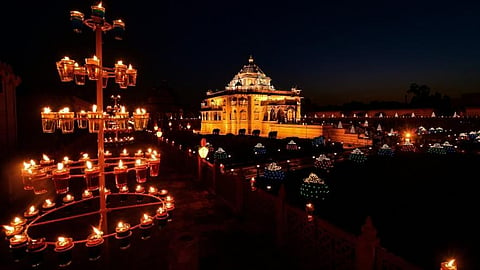
- Home
- Live Blog
- Breaking News
- Top Headlines
- Cities
- NE News
- Sentinel Media
- Sports
- Education
- Jobs

Guwahati: Along with the rest of the nation, the Himalayan state of Sikkim too celebrated Diwali with much pomp and gaiety following all the prolonged traditions and customs of the state. Festival of Diwali or Tihar as known in Sikkim is a five-day long festival and celebrated with much fervor by Nepalis. Like every year, this year too there was a huge sale of various kind of flowers in the market which grabbed the attention of a huge number of buyers. People thronged in huge numbers to buy floras to decorate their houses in the most beautiful ways.
It may be noted that a wide variety of flowers are sold every year as people decorate their houses with flowers. Marigolds are especially used to decorate their homes. People also illuminate their houses on the occasion with various kinds of lights, earthen lamps, and candles.
It needs to be mentioned that one of the most popular and significant Hindu Festivals, Diwali is celebrated under the name of ‘Tihar’ in Sikkim and other parts of North East India. The “festival of lights” covers the entire state in the veil of glittering lamps, offering people an opportunity to remove darkness not only from their homes but, also from their souls. Worship of animals, ‘Laxmi Ganesh Pujan’, bursting of crackers and singing of traditional folk songs called ‘Deusi and Bhailo’ are some of the most important highlights of Tihar, and which are sure to provide tourists and travelers a unique opportunity to witness Sikkim from a different perspective and religion, other than Buddhism.
The five-day long festival begins with the celebrations of ‘Kaag Tihar’, the first day when crows (the symbol of sadness and sorrow) are worshipped and offered with sweets as a belief that doing so would avert grief and death from the homes. The second day, also known as ‘Kukkar Tihar’ is dedicated to dogs. Since dogs own a special place in Hindu mythology, they too are worshipped on this day and are offered with garlands, tika, and sweets.
Third day or the day of Deepavali, also known as ‘Gai Tihar’ in local Sikkimese dialect, is a special day dedicated to cows, the symbol of prosperity and wealth as per Hindu mythological beliefs; cows are garlanded and offered with the green grass. Laxmi Pujan is also done on the day of Gai Tihar. Lights, fireworks and the folk songs of ‘Deusi and Bhailo’, narrating the story of the festival on the night of Gai Tihar provides for a magnetic spectacle, leaving everyone with some wonderful memories of the celebrations. Children and teenagers sing the songs and dance as they go to various homes in their community, collecting money, sweets, food and giving blessings for prosperity. Bhailo is generally sung by girls, while Deusi is sung by boys.
Next two days follow the ‘Govardhan Puja’ and ‘Bhai Tika’, also famous as ‘Bhai Dooj’ in Northern parts of India.
As per sources, Bhai Tika, an important part of the five-day Tihar festival was celebrated with grandeur on Friday. Bhai Tika is an essential part of the festival that celebrates the beautiful bond between siblings. On this day, sisters pray for their brothers’ well being and long life, while brothers vow to protect their sisters. It is also known as Bhaidooj, Bhai Bheej and Bhai Phota in other parts of the country.
Meanwhile, on Friday during the celebration of Deusi when hundreds of people reached out to the residence of Tourism Minister Ugen T. Gyatso and played Deusi, giving an occasion to the Minister to develop mass contact before the approaching elections. The assembled people were voters in the Minister’s constituency and Gyatso interacted with them.
Emphasizing on the need for preserving the tradition of the state on Thursday, Sikkim Chief Minister Pawan Chamling at Mintokghang said, “This is our tradition and we should preserve it.